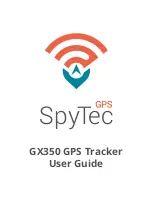
LA000507G © 2006 Navman New Zealand. All rights reserved. Proprietary information and specifications subject to change without notice.
2.8 Environmental
The environmental operating conditions of the Jupiter 20 are as follows:
temperature: –40ºC to +85ºC
humidity
:
up to 95% non‑condensing or a wet bulb temperature of +35ºC
altitude: –304 m to 18 000 m
vibration: random vibration IEC 68‑2‑64
max. vehicle dynamics: 500 m/s
shock (non‑operating): 18 G peak, 5 ms
2.9 Compliances
The Jupiter 20 complies with the following:
Directive 2002/95/EC on the restriction of the use of certain hazardous substances in
electrical and electronic equipment (RoHS)
CISPR22 and FCC: Part 15, Class B for radiated emissions
Automotive standard TS 16949
Manufactured in an ISO 9000 : 2000 accredited facility
2.10 Marking/Serialisation
The Jupiter 20 supports a code 128 barcode indicating the unit serial number. The Navman
13‑character serial number convention is:
characters 1 and 2:
year of manufacture (e.g. 06 = 2006, 07 = 2007)
characters 3 and 4:
week of manufacture (1 to 52, starting first week in January)
character 5:
manufacturer code
characters 6 and 7:
product and type
character 8
: product revision
characters 9-13:
sequential serial number
3.0 Performance characteristics
3.1 TTFF (Time To First Fix)
TTFF is the actual time required by a GPS receiver to achieve a position solution. This
specification will vary with the operating state of the receiver, the length of time since the last
position fix, the location of the last fix, and the specific receiver design.
3.1.1 Hot start
A hot start results from a software reset after a period of continuous navigation, or a return
from a short idle period (i.e. a few minutes) that was preceded by a period of continuous
navigation. In this state, all of the critical data (position, velocity, time, and satellite
ephemeris) is valid to the specified accuracy and available in SRAM (Static Random Access
Memory). Battery backup of the SRAM and RTC during loss of power is required to achieve a
hot start.
3.1.2 Warm start
A warm start typically results from user‑supplied position and time initialisation data or
continuous RTC operation with an accurate last known position available in memory. In this
state, position and time data are present and valid but ephemeris data validity has expired.
3.1.3 Cold start
A cold start acquisition results when either position or time data is unknown. Almanac
information is used to identify previously healthy satellites.
•
•
•
•



































